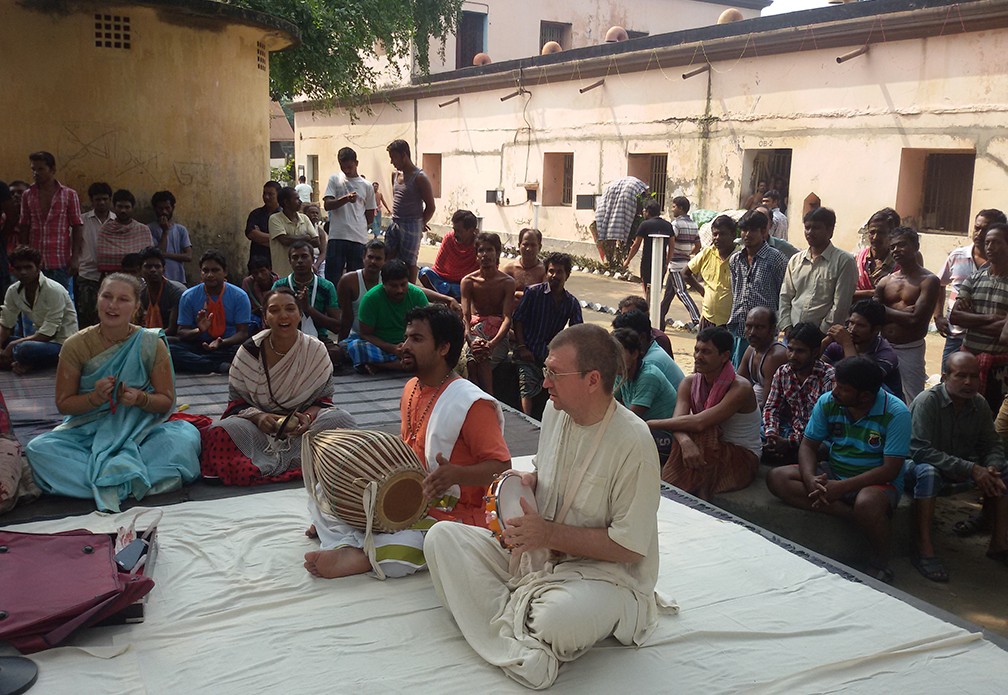
By Urmila devi dasi
I watch the sun rising over the horizon where the Pacific Ocean touches the sky. In the beauty of its red glow painting sea, sky, and clouds, I chant the Brahma gayatri mantra, a meditation on the sun. Receiving and chanting this mantra is an essential part of diksa, initiation into the succession of spiritual teachers and disciples from the beginning of universal creation. Those unfamiliar with gayatri might wonder why modern educated people would mediate on the sun, having been taught that only primitives engage in sun worship. Increasingly, however, people interested in yoga and enlightenment have heard of this queen of mantras which allows entrance into advanced wisdom and realization. Srila Prabhupada’s translation of the Sanskrit of the Brahma gayatri is: “Let us meditate on that worshipable effulgence of the divine sun who enthuses our meditation.”
In the sacred Bhagavatam we find that great saints such as Bharata regularly mediated on a sun mantra. Srila Prabhupada comments (SBp 5.7.13), “The predominating Deity within the sun is Hiranmaya, Lord Narayana. He is worshiped by the gayatri mantra. He is also worshiped by other hymns mentioned in the Rg Veda, for instance: dhyeyah sada savitr-mandala-madhya-varti. Within the sun Lord Narayana is situated and He has a golden hue.” And in his comment on the next verse Prabhupada writes, “Actually Narayana within the sun is maintaining the entire universe. Therefore, Narayana should be worshiped by the gayatri mantra or the Rg mantra.”
Not only have saintly persons throughout history chanted this mantra, but the Supreme Lord Krishna Himself chants the gayatri mantra. In the cities of Dwaraka and Mathura, it’s a part of His daily activities. Although Krsna is the source of the mantra, in the Lord’s pastimes Garga Muni initiated Krsna into the gayatri, and gave Him the sacred thread. This thread crosses the upper body and gets wrapped around one’s fingers while chanting gayatri and thus indicates a person who has been initiated into gayatri. Worship of the sun also exists in Vrndavana where Krishna’s consort Radharani worships the sun daily. The sacred Yamuna River in Vrndavana is the daughter of the sun god. Her twin brother is Yamaraja the lord of death.
What is the benefit for which we are chanting this Brahma gayatri mantra? And why does it give us this kind of benefit? In answering these questions we will examine the nature and origin of the mantra.
Benefit of chanting the Brahma gayatri
In his purport in the Bhagavad Gita (10.35) Prabhupada says that chanting this gayatri mantra is meant for realization of the Supreme Lord. In the first verse of the Bhagavatam, the words satyam param dhimahi indicate that the entire Bhagavatam is an expansion on the Brahma gayatri mantra, which also contains the word dhimahi. In commenting on this verse, Srila Prabhupada says that by chanting the Brahma gayatri, one gains spiritual realization which is a prerequisite for entering into the lilas or sporting pastimes of the Supreme Personality of Godhead, Krsna. Sometimes in a college or school a course has prerequisites—in order to study one course you may already have had to have studied something else. So in order to, as Prabhupada puts it, “relish” Krsna’s lila, one needs purification which is attained by the chanting of the Brahma gayatri mantra. Also Prabhupada says, in 4.21.22 of the Bhagavatam, that by chanting this gayatri mantra one will maintain spiritual strength. People often ask how they can be steady in spiritual practice. The main source of such spiritual strength is Balarama, the original guru. Gayatri’s giving spiritual strength is connected to the fact that one can only receive the fruits of chanting this Brahma gayatri mantra upon receiving it from a guru. If someone just reads the mantra from, say, searching for it on the Internet, or listening to some musical performance of somebody singing it, there will not be any benefit. A genuine guru should only give the gayatri mantra to “spiritually advanced people” for whom it is meant. (Bg 10.35) The spiritual strength found in chanting the mantra, therefore, comes from guru as well as from the mantra itself.
The nature and power of the Brahma gayatri
Why does the gayatri mantra give the benefit of being able to realize God, and the purification that one can then relish Krsna lila? Krsna says in the tenth chapter of Bhagavad Gita that the gayatri mantra is He Himself in poetic form. So gayatri is God as poetry. Also Prabhupada says there in the purport that gayatri is the sound incarnation of Brahman (all pervading spirit) and therefore allows us to realize aham bhrmasmi: I am a spiritual being separate from the body and mind. Interestingly enough, although in the Bhagavad Gita it says gayatri is the sound incarnation of Krsna, in the Bhagavatam (3.13.35), it says that Krsna is the incarnation of the gayatri mantra. That’s because they are non-different, and can be looked at from either perspective.
The Brahma gayatri is complete knowledge. Caitanya Mahaprabhu, speaking to His disciple Sanatana Goswami, (CC Madhya lila 25.147), says gayatri contains sambanda and abedeya, or identity and the process to realize it. Our identity is that we are a part of the Supreme Truth and our process is to mediate on that Truth. The Brama gayatri also contains prayojana, or the result of such meditation, a condition of joyfulness and enthusiasm.
In the Bhagavatam’s description of Krishna’s incarnation as Varaha, the sages say that the gayatri mantra is the touch of the skin of the Lord (3.12.45). Krsna’s skin is very soft. It is described in the Bhakti-rasamrita Sindhu that if the Lord just brushes against a plant, His skin will change color; it’s so delicate. There are many descriptions in sacred writings, especially in Ananda vrindavanacampu, about how the Lord’s skin is soft like butter. One can feel the touch of the Lord simply by chanting the gayatri mantra. Krsna’s touch is described as follows:
By the touch of Lord Krsna’s hand (in His form of Nṛsiṁhadeva) on Prahlāda Mahārāja’s head, Prahlāda was completely freed of all material contaminations and desires, as if he had been thoroughly cleansed. Therefore he at once became transcendentally situated, and all the symptoms of ecstasy became manifest in his body. His heart filled with love, and his eyes with tears, and thus he was able to completely capture the lotus feet of the Lord within the core of his heart.
SB 7.9.6
The gayatri mantra is also the sound of the Lord’s flute which we can hear if we meditate on this mantra. At the dawn of cosmic creation, Krsna played His flute, the sound of which entered into the ear holes of Brahma, the universal engineer. After entering into his ears, the flute sound came out of his mouth as the gayatri mantra. From that mantra, all the sacred literatures of the Vedas expanded, so gayatri is the essence of the Vedic mantras, like boiled down milk fudge (burfi) is the essence of milk. In that way, Krsna’s flute sound manifested the spiritual teachings of humankind. In this world people sometimes become mesmerized when listening to especially beautiful music, so what to speak of a flute song that God Himself plays! One of the many descriptions of Krsna’s flute song is as follows:
The beauty of Kṛṣṇa’s smile is the sweetest feature of all. His smile is like a full moon that spreads its rays throughout the three worlds—Goloka Vṛndāvana, the spiritual sky of the Vaikuṇṭhas, and Devī-dhāma, the material world. Thus Kṛṣṇa’s shining beauty spreads in all ten directions. His slight smiling and fragrant illumination are compared to camphor, which enters the sweetness of His lips. That sweetness is transformed and enters into space as vibrations from the holes of His flute. The sound of Kṛṣṇa’s flute spreads in the four directions. Even though Kṛṣṇa vibrates His flute within this universe, its sound pierces the universal covering and goes to the spiritual sky. (CC Mad 21.139-141)
Considering the many ways in which the Brahma gayatri is described, it is not astonishing that chanting this mantra will bring us realization of Krsna and qualify us to relish Krishna’s pastimes.
Attaining enlightenment
The Brahma gayatri is generally understood, as said earlier, as worship of the sun. The mantra is a request to be illuminated, enthused, with the light of spiritual knowledge, like the sun lights up the cosmos. To be enlightened, in one sense, means to be able to see. If the electricity goes off night, we can’t see anything or do anything. Even materially without the sun, what can we do? Most people go to work when the sun comes up. That’s how we do our activities. Therefore, the sun is not just symbolically but literally giving us clear vision. We can see things as they are. Ultimate seeing and enlightenment is to realize, “Who am I? What is the nature of this world? Who is God? What do I do? What is the best course of action?”
We need clear vision to know how to define ourselves and success, as well as to see the most effective path to that success. All of these answers come with light or enlightenment, as Krsna says, “jnana-dipena bhasvata (Bg 10.11)” I, dwelling in their hearts, destroy with the shining lamp of knowledge the darkness born of ignorance. The Brahma gayatri mantra is a powerful way for this shining light to bring us to knowledge. The mood of chanting the mantra is one of petitioning for grace. As Prabhupada writes:
The Supreme Personality of Godhead, Krsna, cannot be understood by the individual soul through mental, physical or intellectual exercises. It is by the grace of the Supreme Personality of Godhead that the individual soul is enlightened. Therefore, the Lord is described here as atma-pradipa [who gives enlightenment to the living entities]. The Lord is like the sun, which illuminates everything and cannot be illuminated by anyone. Therefore, if one is serious about understanding the Supreme, one must receive enlightenment from Him. (purport SB 8.3.10)
In addition to the fiery sphere of the sun and its effulgence, the saint Jiva Gosvami has explained the Brahma gayatri as indicating Krsna and His energy Radha. Similarly, Srila Prabhupada (CC Mad 8.265p) said that the sun mentioned in the Brahma gayatri is Lord Krishna in His form of Caitanya Mahaprabhu, the ultimate sun. Certainly the ultimate sun, the ultimate light, is God Himself. Krsna says in the Bhagavad gita, “I am the light of the sun.” And in the Bhagavatam’s 8th canto, Krsna’s disc, sudarsana, is also identified as the sun. Both the sun and the sudarsana disc are called the “eye of the Lord.” Sudarshana means auspicious vision, and when one is enlightened one gets a vision of reality, which is all auspicious.
Through study of the benefits and nature of the Brahma gayatri, those of us who already have received this mantra from a bona fide guru can deepen our meditation when we chant daily at sunrise, noon, and sunset. Those of us who haven’t received the gayatri mantra can meditate thrice daily on the light of the sun as Krsna, the eye of the Lord that is actually sustaining everything. To qualify ourselves for initiation into chanting the gayatri mantra, we can have a life filled with light, with goodness. As the Vedas say: Tamaso ma jyotir gamaya, which means “Do not remain in darkness, come to the light.” (lecture Bhagavad-gita 2.16 — Mexico City, February 16, 1975). Krsna in the Gita describes goodness as being symptomized by all the gates (senses) of the body are illumined by knowledge. In a practical sense, such a life means we only allow illuminating, enlightening, uplifting things to enter our senses. For example, one eats only vegetarian food offered to Krsna.Then one has a life that is filled with light.
Beyond goodness, one who wants to be qualified to chant gayatri should aim for a life filled with transcendent light. In this regard, there is a song by Bhaktivinoda Thakura, Mama Mana Mandire, in which he asks Krsna to enter into the temple of his heart. Bhaktivinoda writes about receiving Krsna with the arti ceremony, a welcoming ritual where the most important element is a lamp with a flame. There is a hotel in America that has their slogan, “We leave the lights on for you.” When the lights are on, you know someone’s home. If you want to deter criminals you leave the lights on. When there are big festivals, we have lights. Every culture in the world has a festival that has something to do with lights, or fireworks, or light decorations, or lighting lamps. Even for birthday parties in the West we light candles. So, light is for receiving, welcoming, loving. Bhaktivinoda Thakura says, “What kind of lamp am I going to greet you with my dear Lord, when you enter into the temple of my mind?” Prema pradip, the light of love. When we fill our heart with the light of love of God we are truly enthused in our mediation—the goal of the Brahma gayatri.
Note:
The three parts of the gayatri mantra are described in Bhagavatam 5.9.5 in this way: vyāhṛtibhiḥ sapraṇava-śiras tripadīṁ sāvitrīṁ. Sāvitrīṁ is another name for the sun and refers to the fact that this mantra focus on that source of light and enlightenment. Vyāhṛtibhiḥ means the planetary systems. The sages divide the planets and stars in the universe into groups of 14 or 3 or sometimes 7. In gayatri they are divided into three: bhūr bhuvaḥ svaḥ: Earth, the heavenly planets, and the planets of the sages. Sometimes the acaryas explain that these three divisions are elements of our own embodiment. As the mystic yogis know, the universal body exists in a microcosom in our own body, just like the universe is the body of Lord Brahma. We have, also, a little universe in our own body. Sometimes bhūr is considered the gross body, bhuvaḥ the mind, and svaḥ the intelligence. Then the next word in this verse is Sa meaning that, and then the words praṇava-siras. Siras means head or chief, and pranava indicates Omkara. The word praṇava is understood as a joining of pra an d nu.The simplest meaning of “nu” is simply to make a sound. The prefix pra- has a sense something like “forth” So, praṇava would be the bringing forth of a sound, especially a humming or droning sound. Since “om” is, in one sense, the most fundamental sound, it is called praṇava. However, because there could be many essential sounds, om is here referred to as the sapraṇava-śiras, the chief of all sounds. Then tripadīṁ means three steps or three feet. In fact, gayatri indicates that meter used in poetry. However, if you count the syllabus in the rest of the Brahma gayatri, the first line actually has seven, it doesn’t have eight; so seven, eight, eight. The total structure of the Brahma gayatri, therefore, is that after saying the chief of all sounds, om, and then the names of the three planetary systems, the core of the gayatri mantra is three lines of eight syllables each.
Source: http://urmiladasi.com/enlightenment-brahma-gayatri-mantra/
Lecture on The Science of Consciousness by Ravindra Svarupa Prabhu on 07 Nov 2014 at Carpinteria


























